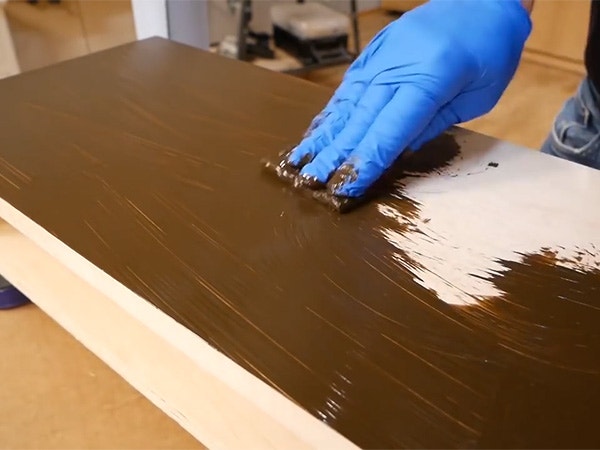How To Apply A Gel Stain On Closed Grained Hardwood
How to apply this finish:
1. Sand the project up through the grits until at least 320-grit. It is a good idea to sand pieces that will be hard to reach before assembly.
2. Wipe the project with mineral spirits to check for glue splotches.
3. Apply a good quality Gel Stain, let dry 24 hours.
4. Use a wipe-on polyurethane type finish.
a. Flood it on and wipe it off.
b. Let rags dry flat and dispose of properly!
5. If you have any nail holes, cracks or defects in the wood, fill them now with a wood filler putty that matches the color of the stained wood (sand smooth).
6. Apply at least two more coats of the urethane.
7. Optional: After the finish has cured for 72 hours, apply a coat of high-quality paste wax and then polish it off.
8. Optional: Substitute a wipe-on Danish Oil applied in the same manner.
Supply Checklist:
Video: How To Apply Oil Stain Finish To Open Grain Hardwood
Rob Johnstone: Today, I'm going to show you how to apply a gel stain on a close grained hardwood. Here's maple, but also would be cherry, birch, walnut. Any of those. Now, if you're using an open grained hardwood like oak or maybe even ash, that's a different process that we'll demonstrate later.
Here's a couple of tips that will help you get great results. First of all, where you can do it, just assemble your project and finish the pieces separately. You'll get way better results that way. Secondly, as you likely know, the key to almost every successful finish is proper surface preparation. Generally, that means sanding.
In most cases, I recommend starting out at 80 grit, and then working all the way up through all the grits. In close grained hardwoods, I recommend stopping at around 320 grit. I have another tip to make sanding easier. Move the sander slowly across the surface, about one inch per second. Most people move the sander far too fast. Neither moving the sander faster nor skipping grits will save you time on this task. Remember, as you advanced to each finer grit, your goal is simply to remove the last grit scratches or sanding marks.
Just one more thing to do before you can start applying the stain, and that's to look for glue spots that have survived the sanding process. They can be from drips or finger smudges. If they're there, they won't absorb the stain in the same way. You have to look for them. How do you do that? I use mineral spirits. You just wipe it on and you look around, and if you find one, like right there, you have to go all the way back to 80 grit sandpaper, sand up through the process all the way to the 320 grit, and then you're ready to apply some color.
Gel stains are the best product I found for staining close grained hardwood like this. They allow you to get a richer color, and they don't blotch in the same way that standard oil stains do. Let me show you how to apply them.
To apply a gel stain like this one, I like to use one of these synthetic scratchy pads to apply the stain. It gets into corners and you can clean it with mineral spirits and even reuse it. Wipe on an even coat of the stain with a circular motion, then wipe off the excess with shop towels, even out the color saturation by feathering a thicker coat where you need it. Check the piece carefully to be sure that you did not miss a spot and let it cure overnight.
Anytime you're using an oil-based product like this a gel stain, it's important that you dispose of your rags and towels properly. Lay them out flat, allow them to dry, and once they're dry, they're landfill safe.
Now we're ready to apply the first coat of polyurethane. I like to wipe it on with a synthetic scratchy pad, moving in circular motion, getting the entire surface wet, and then when I'm done with that, I wipe it off with shop towels. Now's the time to fill any nail holes or cracks that might be in your project. With the stain and the first coat of finish on it, you can more accurately match the color. Now it might come out of the can just perfectly, but the cool thing about this Wunderfil is that you can mix different colors together to get a tone that's perfect. When you wipe on polyurethane, you just flooded on, get all the surfaces wet, and then you wipe it off with shop towels.
When you wipe on a polyurethane, it applies a very thin coat. I recommend at least two or three coats and letting them dry completely between each coat, and if you have to, scuffle sand it a little bit. The last thing you need to remember is that it's an oil-based finish. If you wipe it off, you need to dispose of the rags properly, lay them out flat, let them dry completely, and then they're landfill safe.
That's all there is to it. We put a gel stain on a close grained hardwood, followed with a polyurethane finish. It's easy to do and it looks great. I've got one more tip for you. After the polyurethane is cured for awhile, 72 hours or so, wipe on a coat of a high quality paste wax, rub it on, wipe it off. It'll look great and it'll feel wonderful. I hope you've learned a couple of tricks through this video. Thank you for watching.
Keep the inspiration coming!
Subscribe to our newsletter for more woodworking tips and tricks







